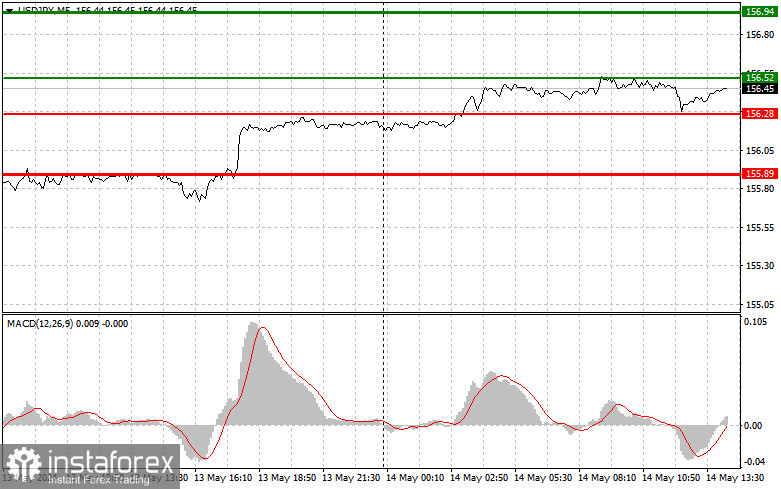Trade analysis and tips for trading the Japanese yen
The first test of the price at 156.52 occurred at a time when the MACD had already risen significantly from the zero mark, which, in my opinion, limited the upward potential of the pair - especially in conditions of low buyer activity around the daily maximum, characterized by weak trading volume. For this reason, I did not buy the dollar. After a short period, the second test of this level at a time when the MACD was in overbought territory provided an opportunity to realize scenario #2 for selling, resulting in a 25-point drop in the pair, after which the pressure sharply decreased, preventing sellers from reaching 156.28. In the second half of the day, the odds will again favor the US dollar. Strong statistics on the Producer Price Index and core producer prices, excluding food and energy, are expected. Federal Reserve Chairman Jerome Powell's firm stance will be another reason for the increase in purchases of the US dollar in continuation of the upward trend. As for the intraday strategy, I plan to act based on the realization of scenarios #1 and #2.
Buy Signal
Scenario #1: Today, I plan to buy USD/JPY when the entry point reaches around 156.52 (green line) to rise to 156.94 (thicker green line on the chart). At around 156.94, I will exit the purchases and open sales in the opposite direction (anticipating a movement of 30-35 points in the opposite direction from the level). After Jerome Powell's speech, the pair will rise today to continue the bullish market. Important! Before buying, ensure that the MACD indicator is above the zero mark and only starting to rise from it.
Scenario #2: Today, I also plan to buy USD/JPY in case of two consecutive tests of the price at 156.28 at a time when the MACD indicator is in oversold territory. This will limit the downward potential of the pair and lead to a reversal of the market upwards. Expect a rise to opposite levels of 156.52 and 156.94.
Sell Signal
Scenario #1: Today, I plan to sell USD/JPY after the level of 156.28 is updated (red line on the chart), leading to a rapid decline in the pair. The key target for sellers will be the level of 155.89, where I will exit sales and immediately open purchases in the opposite direction (anticipating a movement of 20-25 points in the opposite direction from the level). Pressure on the pair will return in case of soft comments from Federal Reserve System representatives regarding inflation. Important! Before selling, ensure that the MACD indicator is below the zero mark and is only starting to decline from it.
Scenario #2: Today, I also plan to sell USD/JPY in case of two consecutive tests of the price at 156.52 at a time when the MACD indicator is in overbought territory. This will limit the upward potential of the pair and lead to a reversal of the market downwards. Expect a decline to the opposite levels of 156.28 and 155.89.

What's on the Chart:
Thin green line - entry price, at which the trading instrument can be bought.
Thick green line - the assumed price where you can set Take Profit or fix profits independently, as further growth above this level is unlikely.
Thin red line - entry price at which the trading instrument can be sold.
Thick red line - the assumed price where you can set Take Profit or fix profits independently, as further decline below this level is unlikely.
MACD indicator. When entering the market, following the overbought and oversold zones is important.
Important. Beginner traders in the forex market must be very careful when making entry decisions. Before important fundamental reports are released, staying out of the market is best to avoid getting caught in sharp exchange rate fluctuations. If you decide to trade during news releases, always set stop orders to minimize losses. You need to set stop orders to avoid losing your entire deposit, especially if you do not use money management and trade with large volumes.
Remember that for successful trading, you need a clear trading plan, like the one presented above. Spontaneous decision-making based on the current market situation is inherently a losing strategy for an intraday trader.
 English
English 
 Русский
Русский Bahasa Indonesia
Bahasa Indonesia Bahasa Malay
Bahasa Malay ไทย
ไทย Español
Español Deutsch
Deutsch Български
Български Français
Français Tiếng Việt
Tiếng Việt 中文
中文 বাংলা
বাংলা हिन्दी
हिन्दी Čeština
Čeština Українська
Українська Română
Română

